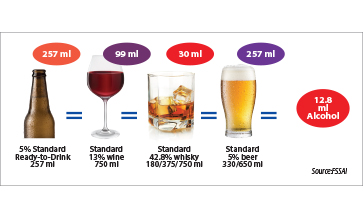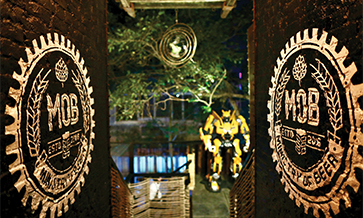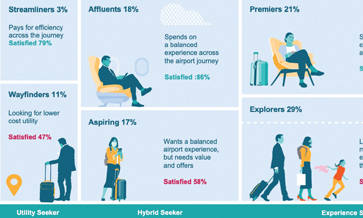According to the Union Ministry of Food Processing Industries, production of alcoholic beverages in the country has increased by about 23.8% during the period between 2015-16 and 2018-19. The alcoholic beverages industry contributes to around 1.5 million jobs in India and generated around US$ 48.8 billion in sales revenue in 2019.
According to industry estimates, the number of people consuming alcohol increased from approximately 219 million in 2005 to 293 million in 2018; it is projected to increase to 386 million by 2030. The share of the upper middle-income group in alcohol consumption has increased steadily from 7% to 21% and is expected to increase to 44% by 2030.
Alcoholic beverages are among the top three sources of revenue earning across most states. Yet there seems to be a lack of transparency, predictability, and clarity in the tax regime.
The states through their excise policies, control the entire supply chain of alcoholic beverages from manufacturing and distribution to registration and retail. There are frequent and ad-hoc changes in these policies, creating uncertainty and preventing manufacturers/ distillers from planning their investment.
Since 2010, more than 78 countries have imposed price controls on alcoholic beverages through an increase in excise taxes to protect consumer health. However, alcohol consumption globally, and in India, is price inelastic, which implies that higher prices may not deter consumption.
Therefore, governments, through right policies, can guide consumers towards lower intake and higher quality higher-quality consumption.
Citing examples of regulations from several countries, a report – titled ‘Developing Principles for Regulation of Alcoholic Beverages Sector in India’ by the Indian Council for Research on International Economic Relations (ICRIER) in New Delhi – points out that such regulations should be designed through extensive data modelling and in a transparent manner. This would protect consumers’ health and at the same time would enable the governments to earn revenue and facilitate exports.
Route to market
States in India decide the channels for alcoholic beverages (beverage) sales through their excise policies. Majorly, there are four types of distribution channels across states:
- Distributor model (company> distributor> retail) in states such as Maharashtra and Assam;
- Corporation model (company>corporation>retail) in states such as Rajasthan, Karnataka, Madhya Pradesh and Tamil Nadu;
- Wholesale model (company>wholesale>retail) in states such as Haryana; and
- Direct model (company>retail) in states such as Delhi.
The report noted wide variations across states in terms of their policies and implementation. Some states lay down new or updated excise policies every year (generally during the beginning of the fiscal year).
In some states, excise policies may not be available online and, if available, may not be updated or may not be available in English, making it difficult for businesses to read and interpret.
From the selected 10 states, in Haryana, Maharashtra, and Odisha, the policies are available in English and for the past five years; in Assam, Delhi, Karnataka, and Telangana, the policies are available in English but cannot be accessed online for the past five years; and in Madhya Pradesh, Rajasthan, and Uttar Pradesh, the policies are not accessible in English but are available for the past five years.
Examples of policies taken from 10 states in this report show that different state policies, and regulations create differences in pricing models, cost structure and taxes, governance models, route-to-market channels and setting up of businesses. Among the 10 identified states, in 2020, the lead time taken to issue licences was highest for Maharashtra (minimum 45 days) and Karnataka (40-45 days).
The lowest lead time was recorded for Uttar Pradesh at 7 working days, in spite of the licences being issued manually. In Assam, the registration and licence- issuing processes are online but, the lead time was recorded at 20 days in the year 2019-2020.
These measures reduce the ease of doing business and dilute the basic premise of ‘Digital India’. It converts India into more than 30 heterogeneous markets instead of a single market.
Price control
The alcoholic beverages sector is kept out of the ambit of the goods and services tax (GST) regime, and as such the state governments have the freedom to implement their independent price control mechanisms, based on their priorities. This creates variation in the pricing models and methodologies applied across states.
In case of calculating the ex-distillery price (EDP) or final price of the products, for whisky, the process of fixing EDP differs across states. In Haryana, Uttar Pradesh and Rajasthan, the lowest EDP among the neighbouring states and in Madhya Pradesh, the lowest EDP across India is taken into account.
Price control is one of the core components of regulating the sector, and variation in taxes and consequently in final prices of products encourages illegal trade from neighbouring states.
Additionally, variation in definitions/terminologies for a final price of products creates barriers for businesses.
The survey highlighted that most states fix their EDPs for whiskey based on the lowest EDP among the neighbouring states, and they do not consider differences in production costs across states.
Further, the EDPs are not revised periodically, ignoring the inflationary pressures. In all, the pricing mechanism is non-transparent due to a lack of evidence-based data-driven policy making.
The report states that the unpredictable nature of the state excise policies and the variations in the timing of their release adversely affect production cycles of manufacturers operating across multiple states. The states have not been able to achieve their desired objective of collecting tax revenues due to the ad-hoc nature of implementing policy changes.
Way forward
The report prescribes five policy recommendations towards developing transparent and predictable regulatory and pricing principles for the alcoholic beverages sector.
1. The state excise departments should lay down clear policies at predictable intervals of not more than 3 years, which can help businesses to expand, to make long-term investments, and encourage new business models to flourish.
To encourage transparency, the excise departments should focus on adopting a ‘cost based’ EDP formula over the ‘minimum EDP’ criteria and evaluate the impact of changes in pricing across various categories of beverages (like premium, standard, etc.) for effective taxation policy.
2. The state excise departments need to switch to digital methods of granting licences and permits, which can prevent unaccounted transactions and corrupt practices. Data analytics and technology-based solutions need to be adopted by the states to monitor the supply chain and develop front-to-back traceability.
3. Develop data-driven models to achieve the desired policy objectives (such as protecting consumer health or enhancing state revenues) and to enhance transparency.
There is a need to invest in collecting structured and periodic data on household consumption patterns (by age, social indicators, area, type of alcohol, etc.) and the impact of price increase or other policy changes on consumption patterns. In this regard, state governments can refer to global best practices for implementing such models.
4. State excise commissioners, finance ministers, and other stakeholders should engage in regular in-depth discussions to start off a process of transparent, predictable and consultation-based price determination.
Such consultations can be held at the level of individual states and on demonstrable metrics being met, a bigger group of states can come together in identifying uniform principles of taxation and to set the stage to develop a transparent and uniform model pricing framework.
The states should also consult and provide inputs to national-level agencies such as the Department of Consumer Affairs, in helping them to establish definitional uniformity regarding (the) maximum retail price (MRP) or minimum selling price (MSP) of products.
5. The government should focus on phased tariff and other duties reduction and Indian companies should be encouraged to export to improve the trade balance. Duty reduction for intermediate products can enhance value addition in India and boost domestic manufacturing potential. (Source: www.icrier.org)














